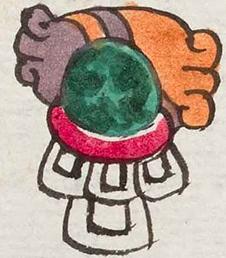Tehuiloyocan (Mdz26r)
This is a compound glyph for the place name Tehuiloyocan. The key word in the construction is tehuilotl, a transparent or translucent stone, which looks much like a chalchihuitl, as it appears in other glyphs (see below). Above the green stone appears a generic stone (tetl), with the usual curling ends and alternating purple and terracotta-orange stripes. A red semi-circle appears below the green stone, and below that are one large and three small concentric rectangles, drawn with black lines and apparently left white intentionally. The locative suffix is not shown visually.
Stephanie Wood
The common stone (purple and orange) underlines the te-, or the phonetic start to the reading of the place name. It also provides a generic category for the green stone (chalchihuitl) that appears just below it. Since jade or jadeite can be translucent, the chalchihuitl may represent the tehuilotl in this case. The -yo- is a type of possessive that accompanies the locative suffix -can, together indicating that this place was known for (or "full of," as Gordon Whittaker explains, 2021, 100) these beautiful stones. The remaining, lower parts of the glyph, including perhaps a red leather strap and some hanging adornments, recall components of something that would have been worn. See the cuauhpilolli and Xocoyol, below, for examples of items that seem to have leather straps.
Other representations of just the chalchihuitl (local jade) have a full red ring around them, which may have something to do here, too, with the partial red ring. The red perimeter for the metaphorical water is like a passage zone to that perceived earthly interior
See our article on red and yellow liners for interiors.
The mottled effect on the green stone, using two shades of green, may intend to convey something of the shape or variable color of the stone as well as swirling water. Local jade was highly prized for its color, like water, which is essential for life. Children were called little green stones, conveying the shared preciosity. Green stones were tribute items that were provided by the commoners to the rulers.
Stephanie Wood
tehuiloyocā. puo
Tehuiloyocan, pueblo (same name today, state of Puebla)
Stephanie Wood
c. 1541, or by 1553 at the latest
Stephanie Wood
The additional elements seem to be iconography.
Two elements contribute to the reading of the place name, although there are more visual elements (iconography) that provide additional, implied meaning.
stones, piedras, jades, joyas, chalchihuites, piel, nombres de lugares

te(tl), stone or rock, https://nahuatl.wired-humanities.org/content/tetl
tehuilo(tl), a transparent or translucent stone, such as crystal, https://nahuatl.wired-humanities.org/content/tehuilotl
yo(tl), having that characteristic or quality/inalienable possession, https://nahuatl.wired-humanities.org/content/yotl
-can (locative suffix), https://nahuatl.wired-humanities.org/content/can-2
-yocan, place where there is a lot of (the preceding noun), https://nahuatl.wired-humanities.org/content/yocan
chalchihui(tl), greenstone, jade, jadeite, https://nahuatl.wired-humanities.org/content/chalchihuitl
Codex Mendoza, folio 26 recto, https://digital.bodleian.ox.ac.uk/objects/2fea788e-2aa2-4f08-b6d9-648c00..., image 62 of 188.
The Bodleian Libraries, University of Oxford, hold the original manuscript, the MS. Arch. Selden. A. 1. This image is published here under the UK Creative Commons, “Attribution-NonCommercial-ShareAlike 3.0 License” (CC-BY-NC-SA 3.0).





